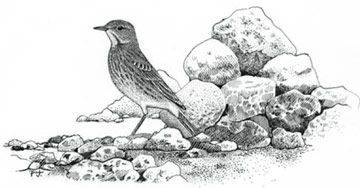Rock Pipit (Anthus petrosus)

Rock Pipit © Phil Jones
Rock Pipits bred on Hilbre in 1987, and probably in 1985 (CWBRs), following other ‘old but not well-documented records of breeding’ (Craggs 1982). But this species does not normally breed anywhere between Llandudno in North Wales and ??? in Cumbria (BTO Second Atlas), and is known in Cheshire and Wirral mainly as a regular winter visitor to the estuarine edges. This Atlas map shows the species more widespread than has previously been reported, in 12 tetrads along the Dee estuary, two on the north Wirral coast and six adjacent to the Mersey estuary. Fieldworkers gave every bird a code of salt-marsh or coastal habitat.
Nothing is known about the origins of the birds wintering in the county. Most British Rock Pipits of the petrosus race are sedentary, only odd birds making an exceptional movement of 100 km or more. Large numbers of the race littoralis migrate to Britain every year from their breeding grounds in coastal Fennoscandia and the nearby Baltic states. Two Swedish-ringed birds have been found in Anglesey and Cornwall, and one ringed in Norway has reached Ireland, so crossing to the west of Britain is not beyond them (Migration Atlas). British Rock Pipits live almost entirely on rocky shores, while littoralis birds occur ‘commonly on soft coastlines usually devoid of Rock Pipits at other times of year, including sand dunes, harbours and, especially, salt-marshes’ (Brown & Grice 2005). Thus, it seems most likely that the birds found annually on the Dee salt-marshes are Scandinavian birds of the littoralis race. This race is a county rarity, with no accepted records, not surprisingly as ‘single specimens of petrosus and littoralis cannot be reliably separated in winter’ (Alström & Mild 2003).
With the apparent separation between Rock Pipits of the two races in habitats and places where they occur, there is probably a separation in their diet as well. The British birds of the rocky coast line feed mostly in the intertidal zone, mainly eating crustaceans, especially tiny periwinkles and amphipods, a resource not exploited by any other passerine. The continental immigrants in the salt-marsh creeks are probably taking the larvae of chironomid midges and other small insects.
Coward (1910) noted that ‘the Rock Pipit is occasionally met with on the shores of the Dee estuary in the winter months’. Bell (1962, 1967) did not comment on its winter status on the coast, but reported inland occurrences, five from the Weaver estuary and one at Altrincham sewage farm. The county bird report for 1980 estimated the wintering population at Gayton Sands reserve as 150-200 birds. In the 1986 CWBR it was ‘apparently common in the winter months at Gayton Sands but numbers are very difficult to estimate owing to the birds’ flightiness and the size of the area’, while in the 1988 report ‘200 were estimated in the salt-marsh creeks’. Otherwise, there are few counts in double figures but the species is frequently noted as underrecorded, with pleas for better information. They are susceptible to hard weather, and most disappeared during the continued frosts of 1981/82, but there have been no extended periods of freezing conditions in the last twenty years. The present wintering population is unknown – the totals of records submitted for this Atlas were 27, 11 and 18 in the three winters – but there is no reason to suppose that it has changed from the 1980s estimates of 200 birds.
There are interesting challenges for the county’s bird-watchers to provide reliable figures for the wintering population and for the county’s ringers to find out more about the origins and destinations of our Rock Pipits.
Sponsored by Jane Turner

